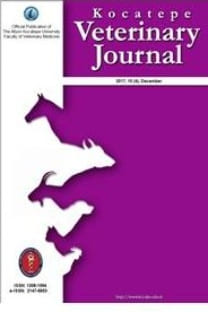Farklı Partenogenetik Aktivasyon Sürelerinin Fare Embriyo Gelişimi ve Kalitesi Üzerine Etkileri
Fare, Oosit, Partenogenetik, Aktivasyon Süresi
Effects of Different Parthenogenetic Activation Periods on Mouse Embryo Development and Quality
Mouse, Oocyte, Parthenogenetic, Activation period,
___
- Alberio R, Zakhartchenko V, Motlik J, Wolf E. Mammalian oocyte activation: lessons from the sperm and implications for nuclear transfer. Int J. Dev. Biol. 2001;45(7): 797-809.
- Bai GY, Song SH, Wang ZD, Shan ZY, Sun RZ et al. Embryos aggregation improves development and imprinting gene expression in mouse parthenogenesis. Dev Growth Differ. 2016;58 (3): 270-279.
- Campbell KHS. Nuclear equivalence, nuclear transfer, and the cell cycle. Cloning. 1999; 1(1): 3–15.
- Cuthbertson KS, Whittingham DG, Cobbold PH. Free Ca2+ increases in exponential phases during mouse oocyte activation. Nature. 1981; 294(5843): 754-757.
- Dandekar PV, Glass RH. Development of mouse embryos in vitro is affected by strain and culture medium. Gamete Res. 1987;17(4): 279–285.
- Daughtry B, Mitalipov S. Concise review: parthenote stem cells for regenerative medicine: genetic, epigenetic, and developmental features. Stem. Cells. Transl. Med. 2014;3(3): 290-298.
- De Sousa PA, Dobrinsky JR, Zhu J, Archibald AL, Ainslie A et al. Somatic cell nuclear transfer in the pig: control of pronuclear formation and integration with improved methods for activation and maintenance of pregnancy. Biol. Reprod. 2002;66(3): 642–650.
- Demir K, Can A, Ertürk E, Özdemirci S, Karacam, H et al. Effect of different activation techniques on immature and in vitro matured cat oocytes. Kafkas Univ. Vet. Fak. Derg. 2014;20: 565-570.
- Didié M, Christalla P, Rubart M, Muppala V, Döker S et al. Parthenogenetic stem cells for tissue-engineered heart repair. J. Clin. Invest. 2013;123(3): 1285-1298.
- Fulka H, Hirose M, Inoue K, Ogonuki N, Wakisaka N et al. Production of mouse embryonic stem cell lines from maturing oocytes by direct conversion of meiosis into mitosis. Stem Cells. 2011;29(3): 517-527.
- Gao W, Yu X, Hao J, Wang L, Qi M et al. Ascorbic acid improves parthenogenetic embryo development through TET proteins in mice. Biosci. Rep. 2019;39 (1): 1-8.
- Han BS, Gao JL. Effects of chemical combinations on the parthenogenetic activation of mouse oocytes. Exp. Ther. Med. 2013;5(5): 1281-1288.
- Heytens E, Soleimani R, Lierman S, De Meester S, Gerris J et al. Effect of ionomycin on oocyte activation and embryo development in mouse. Reprod. Biomed. Online. 2008;17 (6): 764-771.
- Kishikawa H, Wakayama T, Yanagimachi R. Comparison of oocyte-activating agents for mouse cloning. Cloning. 1999;1(3): 153–159.
- Kline D. Activation of the mouse egg. Theriogenology. 1996; 45(1): 81–90.
- Ma SF, Liu XY, Miao DQ, Han ZB, Zhang X et al. Parthenogenetic activation of mouse oocytes by strontium chloride: A search for the best conditions. Theriogenology. 2005;64(5): 1142–1157.
- Mallol A, Santaló J, Ibáñez E. Comparison of three differential mouse blastocyst staining methods. Syst. Biol. Reprod. Med. 2013;59 (2): 117-122.
- Mallol A, Santaló J, Ibáñez E. Psammaplin a improves development and quality of somatic cell nuclear transfer mouse embryos. Cell Reprogram. 2014;16 (5): 392-406.
- Sung LY, Chang CC, Amano T, Lin CJ, Amano M et al. Efficient derivation of embryonic stem cells from nuclear transfer and parthenogenetic embryos derived from cryopreserved oocytes. Cell Reprogram. 2010;12 (2): 203-211.
- Taşkın AC, Kocabay A, Ebrahimi A, Karahüseyinoğlu S, Şahin GN et al. Leptin treatment of in vitro cultured embryos increases outgrowth rate of inner cell mass during embryonic stem cell derivation. In Vitro Cell Dev. Biol. Anim. 2019a;55 (7): 473-481.
- Taşkın AC, Kocabay A. Leptin supplementation in embryo culture medium increases in vivo implantation rates in mice. Turk J Vet Anim Sci.2019b;43 (3): 359-363.
- Versieren K, Heindryckx B, Lierman S, Gerris J, De Sutter P. Developmental competence of parthenogenetic mouse and human embryos after chemical or electrical activation. Reprod Biomed Online.2010;21(6): 769-775.
- Wakayama T, Perry AC, Zuccotti M, Johnson KR, Yanagimachi R. Full-term development of mice from enucleated oocytes injected with cumulus cell nuclei. Nature. 1998;394 (6691): 369-374.
- ISSN: 1308-1594
- Yayın Aralığı: Yılda 4 Sayı
- Başlangıç: 2008
- Yayıncı: Afyon Kocatepe Üniversitesi
Pet Hayvanı Sahiplerinin Hayvan Refahı Tutumu: Türkiye'nin Orta ve Batısında Bir Araştırma
Gizem Sıla KUBİLAY SARIAL, Zehra BOZKURT
Elektron Demeti ile Işınlama Tekniğinin Hayvansal Ürünlerin Raf Ömrünün Uzatılmasında Kullanımı
Bali Damızlık Sığır (Bos javanicus) Sürülerinde Akrabalık Durumu
Widya PİNTAKA BAYU PUTRA, Muzawar MUZAWAR
Ardahan Yöresindeki İneklerde Ketozis Yaygınlığının Araştırılması
Cemalettin AYVAZOĞLU, Erhan GÖKÇE
Kızıl geyiklerde (Cervus elaphus) Elaphostrongylus cervi (Cameron, 1931): Türkiye’de İlk Kayıt
Kürşat KARTAL, Mustafa ESER, Hakan GÜZEL
Keçi Sütünde Bazı Kalite Parametreleri İçin Metot Validasyonu
İrem KARAASLAN, Baran ÇAMDEVİREN, Hüseyin ÖZKAN, Akın YAKAN
Onur BASBUG, Uğur AYDOĞDU, Zahid Tevfik AĞAOĞLU
Civcivlerde Dalağın Embriyonik Gelişiminin Morfohistometrik Değerlendirmesi
Fatma ÇOLAKOĞLU, Muhammet Lütfi SELÇUK
